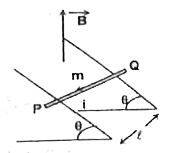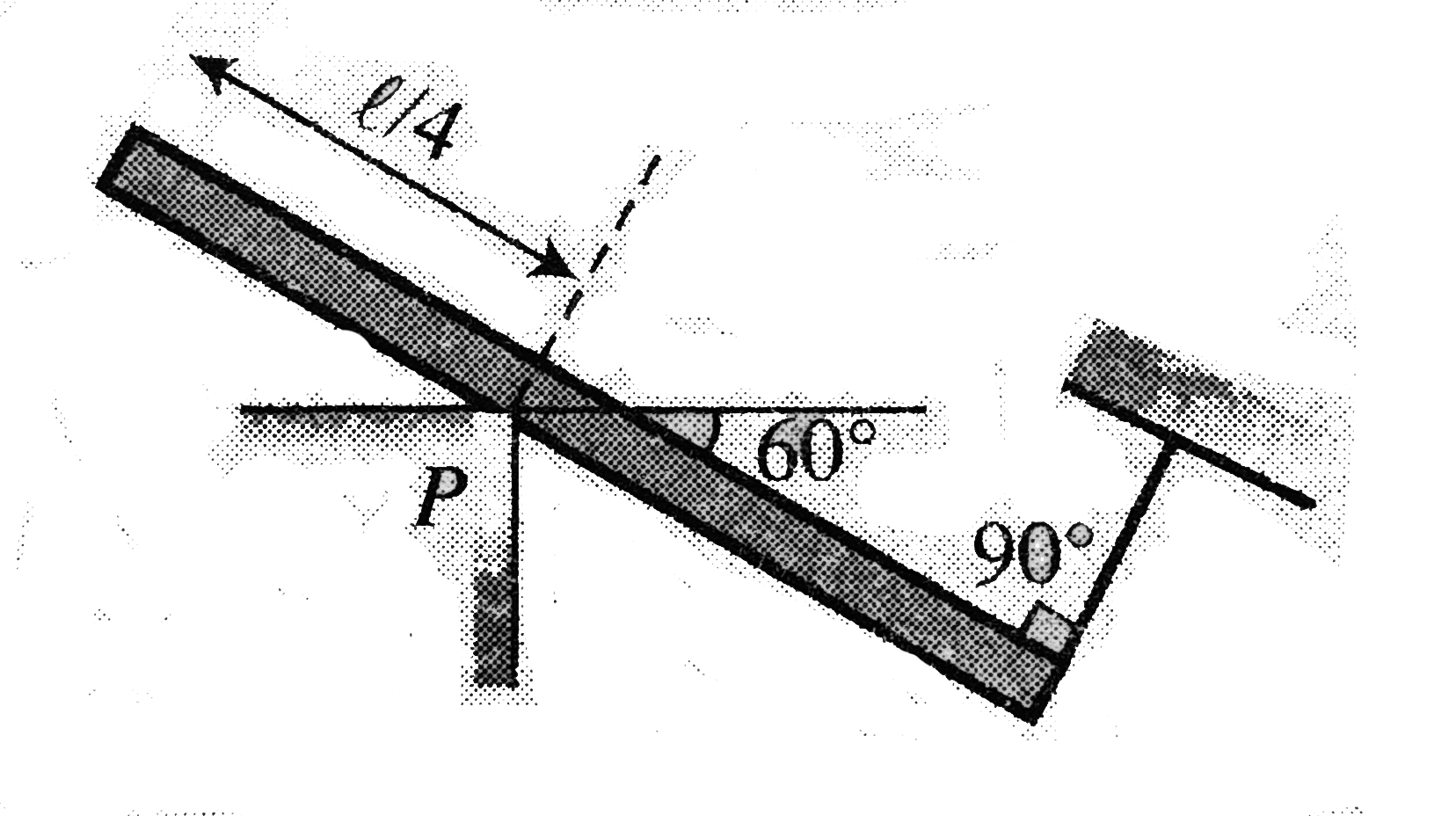Find the current in the conductor PQ so that it remains in equilibrium under its own weight and the magnetic force. If direction of current is reversed then what would be initial acceleration of the rod? Mass of the rod is m. (Friction is assumed to be absent)

Magnetic force on the conductor is equal to Fm=Bil. This force is along horizontal. Direction of I should be from Q to P. In this case its component Fmcosθ will balance mg sinθ to keep it in equilibrium.
Since the rod can not move along perpendicular to the
plane of the rails
Hence for equilibrium Fmcosθ=mgsinθ
⇒Fm=mgtanθ
⇒BIl=mgtanθ⇒i=mgtanθ/Bl
On reversing the direction of current accleration of the rod will be
a=Fmcosθ+mgsinθm=BIlcosθ+mgsinθm=2gsinθ

Topper's Solved these Questions
- BOOK - FIITJEECHAPTER - MAGNETICEXERCISE - Solved Problems (Objective)14videos
MAGNETIC
- BOOK - FIITJEECHAPTER - MAGNETICEXERCISE - Comprehension-13videos
MAGNETIC
- BOOK - FIITJEECHAPTER - MAGNETICEXERCISE - Numerical Based Type2videos
MAGNETIC
- BOOK - FIITJEECHAPTER - LAWS OF MOTIONEXERCISE - COMPREHENSION-III2videos
LAWS OF MOTION
- BOOK - FIITJEECHAPTER - MAGNETISMEXERCISE - Example12videos
MAGNETISM
Similar Questions
A straight horizontal conducting rod of length of 0.45 m and mass 60 g is suspended by two vertical wires at its ends. A current of 5.0 A is set up in the rod through the wires.
(a) What magnetic field should be set up normal to the conductor in order that the tension in the wire is zero?
(b) What will be the total tension in the wires if the direction of current is reversed keeping the magnetic field same as before? (Ignore the mass of the wires) g=9.8ms−2View SolutionMaterial : Flexible copper wire, stand, electric cell, a horseshoe magnet with a strong magnetic field. Procedure : Using the stand, fix the copper wire so that it passes through the poles of the horse-shoe magnet as shown in the figure 4.17. Connect the circuit as well. What do you observe? Whenever a current is not flowing through the wire, it remains straight ( position A). When the current flows from top to bottom, the wire bends and comes into position C.If the current direction is reversed, i.e. it flows from the bottom to the top end, the wire bends but comes in the position B. This means the direction of the force on the wire is perpendicular to both the magnetic field and the direction of the current.
Here, the direcțion of magnetic field is from N to S, (H). In this experiment it is noted that whenever a current flows through a conductor in the presence of magnetic field, a force is exerted on the conductor. If the direction of the current is réversed, the direction of the force also gets reversed. If the magnet is kept reversed, i.e. its South pole is brought at the position of its North pole and its North pole brought to the position of its South pole, what will happen?View SolutionA straight horizontal conducting rod of length 0⋅45m and mass 60g is suspended by two vertical wires at its end. A current of 5⋅0A is set up in the rod through the wires. (a) What magnetic field should be set up normal to the conductor in order that the tension in the wires is zero? (b) What will be the total tension in the wires if the direction of current is reversed, keeping the magnetic field same as before. (Ignore the mass of the wire) g=9⋅8ms−2.
View SolutionA straight horizontal conducting rod of length 0⋅60m and mass of 60g is suspended by two vertical wires at its ends. A current of 5⋅0A is set up in the rod through the wire. (a) What magnetic field should be set up normal to the conductor in order that the tension in the wire is zero?
(b) What will be total tension in the wires if the direction of current is reversed, keeping the magnetic field same as before (Ignore mass of the wire), g=10ms−2.View SolutionAnswer question numbers (a)-(d) on the basis of your understanding of the following paragraph and the related studied concepts :
Oersted demonstrated that an electric current flowing through a conductor produces a magnetic field. The field so produced exerts a force on a magnet placed in the vicinity of the conductor. Ampere suggested that the magnet must also exert an equal and opposite force on the current carrying conductor. The direction of the force on the conductor depends upon the direction of current as well as the direction of magnetic field. Force acting on the conductor is found maximum when the direction of current is at right angles to the direction of the the magnetic field. In such a condition we can use a simple rule to find the direction of the force on the conductor Electric motor, electric generator, microphone, loudspeaker and measuring instruments etc. make use of current carrying conductors and magnetic fields.
What happens to the direction of force experienced by a current carrying conductor placed in a magnetic field if direction of current flow is reversed ?View SolutionAnswer question numbers (a)-(d) on the basis of your understanding of the following paragraph and the related studied concepts :
Oersted demonstrated that an electric current flowing through a conductor produces a magnetic field. The field so produced exerts a force on a magnet placed in the vicinity of the conductor. Ampere suggested that the magnet must also exert an equal and opposite force on the current carrying conductor. The direction of the force on the conductor depends upon the direction of current as well as the direction of magnetic field. Force acting on the conductor is found maximum when the direction of current is at right angles to the direction of the the magnetic field. In such a condition we can use a simple rule to find the direction of the force on the conductor Electric motor, electric generator, microphone, loudspeaker and measuring instruments etc. make use of current carrying conductors and magnetic fields.
Name the rule to find the direction of the force acting on a current carrying conductor placed at light angles to a magnetic field.View SolutionAnswer question numbers (a)-(d) on the basis of your understanding of the following paragraph and the related studied concepts :
Oersted demonstrated that an electric current flowing through a conductor produces a magnetic field. The field so produced exerts a force on a magnet placed in the vicinity of the conductor. Ampere suggested that the magnet must also exert an equal and opposite force on the current carrying conductor. The direction of the force on the conductor depends upon the direction of current as well as the direction of magnetic field. Force acting on the conductor is found maximum when the direction of current is at right angles to the direction of the the magnetic field. In such a condition we can use a simple rule to find the direction of the force on the conductor Electric motor, electric generator, microphone, loudspeaker and measuring instruments etc. make use of current carrying conductors and magnetic fields.
An electric motor and a generator both make use of current carrying conductors and magnetic fields, then what is the difference between the two. Give any one point.View SolutionAnswer question numbers (a)-(d) on the basis of your understanding of the following paragraph and the related studied concepts :
Oersted demonstrated that an electric current flowing through a conductor produces a magnetic field. The field so produced exerts a force on a magnet placed in the vicinity of the conductor. Ampere suggested that the magnet must also exert an equal and opposite force on the current carrying conductor. The direction of the force on the conductor depends upon the direction of current as well as the direction of magnetic field. Force acting on the conductor is found maximum when the direction of current is at right angles to the direction of the the magnetic field. In such a condition we can use a simple rule to find the direction of the force on the conductor Electric motor, electric generator, microphone, loudspeaker and measuring instruments etc. make use of current carrying conductors and magnetic fields.
How can you demonstrate that an electric current flowing through a conductor produces a magnetic field around it?View SolutionA uniform rod of mass m and length l is in equilibrium under the action of constraint forces, gravity and tension in the string. Find the

a. frictional force acting on the rod.
b. tension in the string.
c. normal reaction on the rod.
Now, the string is cut. Find the
d. angular acceleratiion of the rod just after the string is cut.
e. normal reaction on the rod just after the string is cut.View SolutionA uniform rod of length l and mass M pivoted about its end as shown in Fig. and is free to rotate in the vertical plane about the pivot. The rod is released from rest in the horizontal position.
(a) What is the initial angular acceleration of the rod?

(b) Find the initial acceleration of the right end of the rod?
( c) Find normal contact force due to hinge when rod has rotated through angle θ as shown in Fig.View Solution

